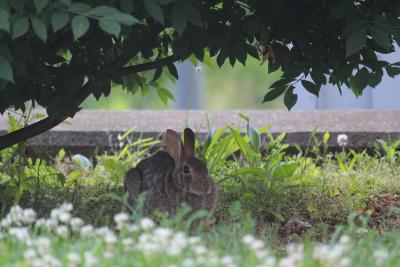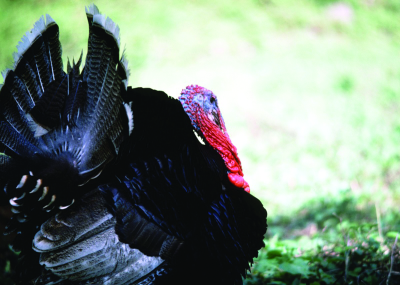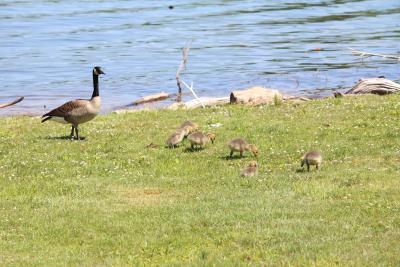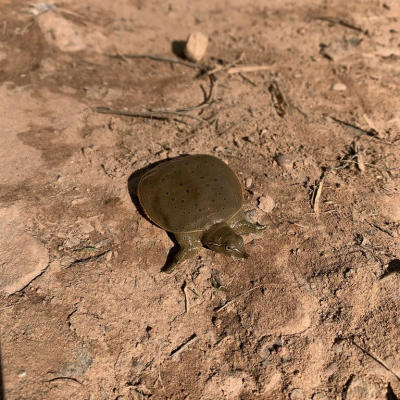The Raystown Lake Region is more than just a destination – it's a sanctuary for wildlife, a place where nature thrives and flourishes. As visitors explore the trails, forests, and waterways of the region, they become part of a larger ecosystem, one that relies on respect, conservation and appreciation for its native inhabitants. From the awe-inspiring sight of bald eagles soaring overhead to the gentle presence of white-tailed deer grazing in meadows, the region offers a glimpse into the wonders of the natural world. While these critters bring joy and wonder to those who encounter them, it's essential to remember that they are wild animals deserving of respect and consideration. Interacting with them should always be done with caution, maintaining a safe distance and avoiding behaviors that could stress or harm them. Appreciating their beauty from afar ensures both their well-being and yours.
 Sprawling woodlands interspersed with meadows and clearings offer ample food sources and shelter for the white-tailed deer. As their name suggests, white-tailed deer are characterized by their strikingly bushy white tails, which they raise as a warning signal when alarmed. One of the most distinctive features of white-tailed deer is their antlers, which are grown and shed annually by males. As herbivores, they help control plant populations and shape the structure of forest ecosystems through browsing. Additionally, they are an important prey species for predators such as coyotes and black bears, contributing to the intricate web of wildlife interactions.
Sprawling woodlands interspersed with meadows and clearings offer ample food sources and shelter for the white-tailed deer. As their name suggests, white-tailed deer are characterized by their strikingly bushy white tails, which they raise as a warning signal when alarmed. One of the most distinctive features of white-tailed deer is their antlers, which are grown and shed annually by males. As herbivores, they help control plant populations and shape the structure of forest ecosystems through browsing. Additionally, they are an important prey species for predators such as coyotes and black bears, contributing to the intricate web of wildlife interactions.
 Venture into the woodlands, meadows, and even neighborhoods of the Raystown Lake Region, and you may just catch a glimpse of the eastern cottontail rabbit. True to their name, eastern cottontails sport distinctive fluffy white tails, resembling balls of cotton. Their large, expressive eyes and long ears add to their endearing appearance, making them a favorite subject for wildlife photographers and artists alike. Eastern cottontails are herbivores, with a diet consisting primarily of grasses, clover, and other green vegetation.
Venture into the woodlands, meadows, and even neighborhoods of the Raystown Lake Region, and you may just catch a glimpse of the eastern cottontail rabbit. True to their name, eastern cottontails sport distinctive fluffy white tails, resembling balls of cotton. Their large, expressive eyes and long ears add to their endearing appearance, making them a favorite subject for wildlife photographers and artists alike. Eastern cottontails are herbivores, with a diet consisting primarily of grasses, clover, and other green vegetation.
 The Raystown Lake Region provides an ideal habitat for wild turkeys. With its mix of dense forests, open fields, and abundant water sources, this region offers everything these birds need to thrive. The most distinctive physical feature of the wild turkey is the bare, fleshy patch of skin on their necks - the wattle! They can also be identified by their unique gobbling. Turkeys' diet consists of seeds, fruits, insects, and small reptiles, making them a valuable part of the ecosystem's health.
The Raystown Lake Region provides an ideal habitat for wild turkeys. With its mix of dense forests, open fields, and abundant water sources, this region offers everything these birds need to thrive. The most distinctive physical feature of the wild turkey is the bare, fleshy patch of skin on their necks - the wattle! They can also be identified by their unique gobbling. Turkeys' diet consists of seeds, fruits, insects, and small reptiles, making them a valuable part of the ecosystem's health.
 Those traveling through the region might be lucky enough to spot our national bird in the wild - the bald eagle. These protected birds are unmistakable, sporting white feathers on their heads and tails contrasting against the dark brown of their bodies. Primarily found near large bodies of open water, they are known to frequent the shores of Raystown Lake which provides an ideal habitat year-round with its abundance of fish and secluded coves. There are currently 6 confirmed nests near the shores of Raystown Lake, with 3 pairs recently welcoming eaglets!
Those traveling through the region might be lucky enough to spot our national bird in the wild - the bald eagle. These protected birds are unmistakable, sporting white feathers on their heads and tails contrasting against the dark brown of their bodies. Primarily found near large bodies of open water, they are known to frequent the shores of Raystown Lake which provides an ideal habitat year-round with its abundance of fish and secluded coves. There are currently 6 confirmed nests near the shores of Raystown Lake, with 3 pairs recently welcoming eaglets!
 Waterfowl are highly adaptable birds, thriving in various aquatic environments, from tranquil ponds to rushing rivers. In the Raystown Lake Region, several species of duck and geese can be spotted gracing the shores of Raystown Lake itself, as well as the surrounding streams, marshes, and wetlands. Waterfowl are social creatures, often forming tight-knit groups known as flocks or rafts. These gatherings serve not only as a means of socializing but also as a strategy for safety, with individuals keeping a watchful eye out for potential predators.
Waterfowl are highly adaptable birds, thriving in various aquatic environments, from tranquil ponds to rushing rivers. In the Raystown Lake Region, several species of duck and geese can be spotted gracing the shores of Raystown Lake itself, as well as the surrounding streams, marshes, and wetlands. Waterfowl are social creatures, often forming tight-knit groups known as flocks or rafts. These gatherings serve not only as a means of socializing but also as a strategy for safety, with individuals keeping a watchful eye out for potential predators.
 Known by various names including woodchuck, whistlepig, or land-beaver, groundhogs thrive in areas where they can dig extensive burrow systems for shelter and forage for vegetation. You're likely to spot them in open fields, along wooded edges, or even in suburban areas where there's a mix of greenery and open spaces. Despite their cute and seemingly docile demeanor, groundhogs play an essential role in their ecosystem. They primarily feed on grasses, clover, and other vegetation, helping to control plant growth and maintain ecosystem balance.
Known by various names including woodchuck, whistlepig, or land-beaver, groundhogs thrive in areas where they can dig extensive burrow systems for shelter and forage for vegetation. You're likely to spot them in open fields, along wooded edges, or even in suburban areas where there's a mix of greenery and open spaces. Despite their cute and seemingly docile demeanor, groundhogs play an essential role in their ecosystem. They primarily feed on grasses, clover, and other vegetation, helping to control plant growth and maintain ecosystem balance.
 The region is home to a bustling community that often goes unnoticed by many visitors—squirrels. These furry creatures thrive in the diverse habitats provided by the mix of forests, meadows, and urban spaces. Two types of squirrels are found in the Raystown Lake Region: the eastern gray squirrel and the American red squirrel. One of their most distinguishing features is, of course, their bushy tails, which are useful for balance and communication. Squirrels are masters of agility and also play a crucial role in maintaining the balance of the ecosystem.They aid in the regeneration of forests by burying nuts and seeds, and serve as a vital food source for predators.
The region is home to a bustling community that often goes unnoticed by many visitors—squirrels. These furry creatures thrive in the diverse habitats provided by the mix of forests, meadows, and urban spaces. Two types of squirrels are found in the Raystown Lake Region: the eastern gray squirrel and the American red squirrel. One of their most distinguishing features is, of course, their bushy tails, which are useful for balance and communication. Squirrels are masters of agility and also play a crucial role in maintaining the balance of the ecosystem.They aid in the regeneration of forests by burying nuts and seeds, and serve as a vital food source for predators.
 A variety of turtle species, including box turtles, painted turtles, and northern map turtles call this region home. From the serene shores of Raystown Lake to the surrounding forests, you may catch a glimpse of these elusive reptiles gliding through the water or basking in the sun. Several of these native reptiles are considered “species of special concern” due to shoreline habitat loss and road mortality. Since 2021, the U.S. Army Corps of Engineers and Juniata College have partnered to create turtle nesting habitats that mimic natural conditions. In an effort to protect and boost turtle populations, the groups work together to build two nesting mound sites. These nesting mounds have proven to be highly successful, as they have documented and released over 600 hatchlings belonging to vulnerable species.
A variety of turtle species, including box turtles, painted turtles, and northern map turtles call this region home. From the serene shores of Raystown Lake to the surrounding forests, you may catch a glimpse of these elusive reptiles gliding through the water or basking in the sun. Several of these native reptiles are considered “species of special concern” due to shoreline habitat loss and road mortality. Since 2021, the U.S. Army Corps of Engineers and Juniata College have partnered to create turtle nesting habitats that mimic natural conditions. In an effort to protect and boost turtle populations, the groups work together to build two nesting mound sites. These nesting mounds have proven to be highly successful, as they have documented and released over 600 hatchlings belonging to vulnerable species.
 With its diverse array of wetlands, streams, ponds, and wooded areas, this region offers an ideal habitat for various frog species including gray treefrogs, wood frogs, spring peepers, and more. These cold-blooded amphibians are highly adaptable, utilizing powerful hind legs to propel themselves through the air with remarkable precision. Frogs are also incredible swimmers and can often be found effortlessly navigating the area's tranquil waters.
With its diverse array of wetlands, streams, ponds, and wooded areas, this region offers an ideal habitat for various frog species including gray treefrogs, wood frogs, spring peepers, and more. These cold-blooded amphibians are highly adaptable, utilizing powerful hind legs to propel themselves through the air with remarkable precision. Frogs are also incredible swimmers and can often be found effortlessly navigating the area's tranquil waters.
 A number of feathered musicians, aptly called “songbirds”, can be found throughout the region. Songbirds are renowned for their melodious vocalizations, which are unique to each species and serve as crucial communication tools. Several vibrant species can be found in wooded areas, such as cardinals, sparrows, robins, finches, and warblers. Hiking trails such as the Terrace Mountain Trail provide excellent opportunities for birdwatching, allowing visitors to immerse themselves in the symphony of nature while exploring the region's scenic beauty.
A number of feathered musicians, aptly called “songbirds”, can be found throughout the region. Songbirds are renowned for their melodious vocalizations, which are unique to each species and serve as crucial communication tools. Several vibrant species can be found in wooded areas, such as cardinals, sparrows, robins, finches, and warblers. Hiking trails such as the Terrace Mountain Trail provide excellent opportunities for birdwatching, allowing visitors to immerse themselves in the symphony of nature while exploring the region's scenic beauty.
 While uncommon, several elusive species of wildlife have been documented in the Raystown Lake Region. This includes creatures like porcupines, river otters, black bears, red and gray foxes, beavers, and minks. Seeing these rare animals in their natural habitat is not only a privilege but also an excellent reminder of the need to protect and preserve our wild spaces for years to come.
While uncommon, several elusive species of wildlife have been documented in the Raystown Lake Region. This includes creatures like porcupines, river otters, black bears, red and gray foxes, beavers, and minks. Seeing these rare animals in their natural habitat is not only a privilege but also an excellent reminder of the need to protect and preserve our wild spaces for years to come.
